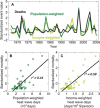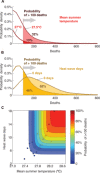Increasing probability of mortality during Indian heat waves
- PMID: 28630921
- PMCID: PMC5462497
- DOI: 10.1126/sciadv.1700066
Increasing probability of mortality during Indian heat waves
Abstract
Rising global temperatures are causing increases in the frequency and severity of extreme climatic events, such as floods, droughts, and heat waves. We analyze changes in summer temperatures, the frequency, severity, and duration of heat waves, and heat-related mortality in India between 1960 and 2009 using data from the India Meteorological Department. Mean temperatures across India have risen by more than 0.5°C over this period, with statistically significant increases in heat waves. Using a novel probabilistic model, we further show that the increase in summer mean temperatures in India over this period corresponds to a 146% increase in the probability of heat-related mortality events of more than 100 people. In turn, our results suggest that future climate warming will lead to substantial increases in heat-related mortality, particularly in developing low-latitude countries, such as India, where heat waves will become more frequent and populations are especially vulnerable to these extreme temperatures. Our findings indicate that even moderate increases in mean temperatures may cause great increases in heat-related mortality and support the efforts of governments and international organizations to build up the resilience of these vulnerable regions to more severe heat waves.
Keywords: Heatwaves; climate extremes; mortality.
Figures




References
-
- T. Stocker, D. Qin, G.-K. Plattner, M. Tignor, S. K. Allen, J. Boschung, A. Nauels, Y. Xia, V. Bex, P.M. Midgley, IPCC, 2013: Climate Change 2013: The Physical Science Basis. Contribution of Working Group I to the Fifth Assessment Report of the Intergovernmental Panel on Climate Change (Cambridge Univ. Press, 2013), 1535 pp.
-
- Meehl G. A., Tebaldi C., More intense, more frequent, and longer lasting heat waves in the 21st century. Science 305, 994–997 (2004). - PubMed
Publication types
MeSH terms
LinkOut - more resources
Full Text Sources
Other Literature Sources

